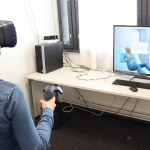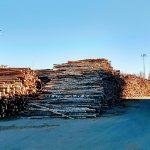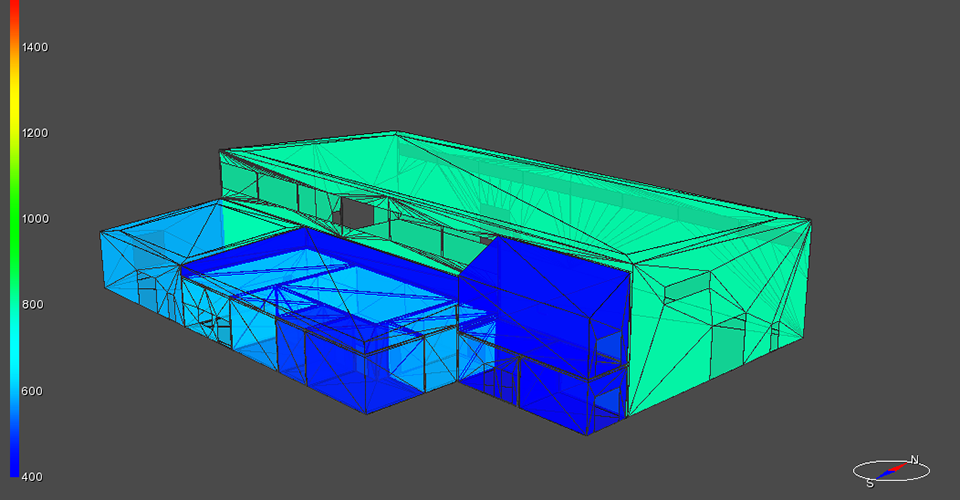
Sy Nguyen-Ky & Nhung Nguyen
Computer chess game is one of the most basic examples of simulation. Current chess engines have been able to defeat even the strongest human players. What if similar simulations could defeat our engineering problems in the same manner? This article will present the importance of simulation in building performance optimisation in the digital era and how its effectiveness has academically and industrially shifted over time, from the view of an engineering trainee. A practice of simulation tool in a student project will be introduced and its apparent educational values, as well as the future development of simulation as a helpful tool for advanced energy solutions, are promoted.
Simulation in multidisciplinary building performance optimisation
Simulation is basically the imitation of a situation or process. Nowadays, simulation more probably refers to computational models of processes from various sectors, from fluid mechanics to socio-economics. Building performance with computers involved was introduced in the 1970s, which has brought the practitioners both conveniences and challenges. Instead of piloting an idea in the first place, a significant amount of money and time could be saved by initial simulation. Building performance simulation (BPS), theoretically, has to gather information from many sources; likewise, the range of disciplines across which it is processed is extensive. The result of a simulation, or the representative physical state of a building, is thus prone to a high level of uncertainty. Even so, over time, the capability of manipulating the set of environmental and intrinsic parameters has been continuously developed and enhanced, which makes BPS a notable stand in predicting, assessing and verifying building performance.
In today’s changing world, the need for housing due to the global population growth is pushing the construction sector to discover more eco-friendly and sustainable approaches. Together with the increasing demands for occupant comfort, the rising awareness of relation among indoor environment, health and productivity, the purposes of BPS have shifted from the above-mentioned functions to the construction of a more effective and stable built environment (Hensen, 2007, p. 57). In other words, the new aim is optimisation, which can be achieved with the great help of BPS.
BPS’s transition from a research-oriented to an industrial designing and educational tool
The presence of BPS in construction workflow has essentially changed the way we build, from the concept to the decision-making process. Pilots are implemented with improvement in robustness and fidelity while quality assurance in building design, construction, operation, maintenance, and management is now equipped with many applications with simulation embedded. Automated building fault detection and diagnostics, aided by BPS and the IoT technology – sensing, computing and communicating, has become a valuable tool to maintain the efficiency of high-performance buildings – the building paradigm of the era. Still, before the time when BPS tools became widely available with graphical user interfaces, the term BPS sounded familiar only to experts with deep knowledge in the field and was used mostly for research purposes. Fortunately, for the past several decades, BPS tools and their advance to offer a broader range of users have enabled the “potential to improve competitiveness, productivity, quality and efficiency in buildings and in the construction industry as well as facilitating future innovation and technological progress” (Hensen, 2007, p. 59). In a way, those changes have turned simulation to be a tool not only for research but also for industrial designs. Moreover, a user-centric approach to BPS brings it to an even wider variety of uses: product development to commercialise, policy making to adapt climate change, or to enhance existing standards and regulations. The involvement of BPS in the prediction, assessment, and verification of building performance can ease the attainment of international environmental programmes such as LEED (Leadership in Energy and Environmental Design) and BREEAM (Building Research Establishment Environmental Assessment Method).
On the other hand, BPS tools also provoke knowledge acquirement to non-professional users. One of the difficulties one faces when learning to use BPS tools, which is deemed to be “obstructive” sometimes, is to deal with uncertainty; because built environment embodies arbitrary complexity, where parameters are abundant but never sufficient in dynamic simulation. This is when the user recognizes such complexity and BPS pushes them to strengthen their background in order to identify the most influencing parameters. An approach to BPS does not necessarily generate something in the first place, yet it stimulates the user to understand the model through disparity between expectations and simulated results from inappropriate inputs. Regarding this matter, Bellinger (2004) concluded: “After having been involved in numerous modelling and simulation efforts, which produced far less than the desired results, the nagging questions becomes: Why? The answer lies in two areas. First, we must admit that we simply do not understand. And, second, we must pursue understanding. Not answers but understanding”.
STES – a student project as an application of BPS
At HAMK Tech, BPS has been practiced in planning and designing a small-scaled underground Seasonal Thermal Energy Storage (STES) as a student project in 2018. The idea is to capture thermal energy from renewable sources, transfer it into a thermal storing medium or a mixture of media when heat is abundant, and extract heat from it when needed (Figure 1). STES, again, is not a new concept, but its practice and application in Finland still remain unpopular. The team aims at the production of a complete STES system as a small-scaled advanced energy solution, with the aid of BPS tool. The arguments for and against building STES were assessed when applying into Finnish construction conditions. In the end, the pluses were proven to outweigh the drawbacks, in the case of building a local small-scaled STES which serves one detached house. The noteworthy point lies in the Finnish favourable weather properties, which have high levels of solar radiation while imposing a low demand for heating in summer.
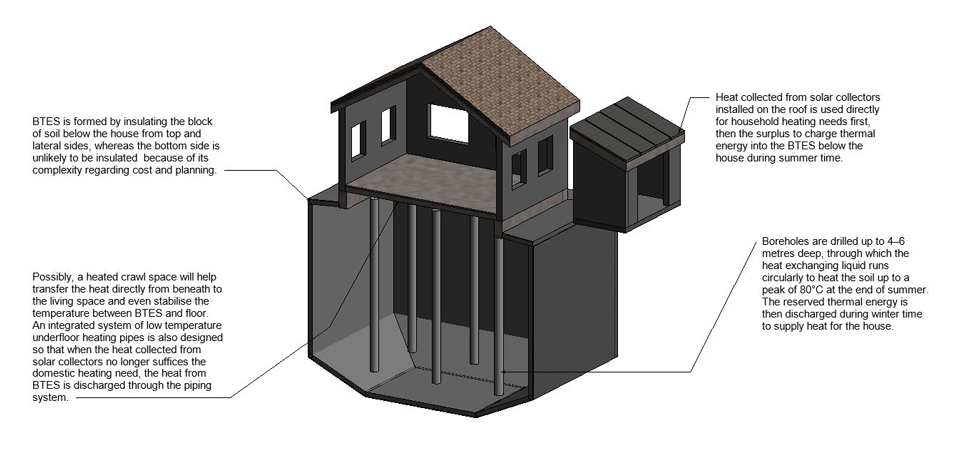
IDA ICE (stands for IDA Indoor Climate and Energy) by EQUA Simulation AB is an end-user simulation tool for people with a limited amount of experience in simulation. It was used to practice BPS in the student project. The pilot STES, which is planned to be built based on an already constructed mobile laboratory in Hämeenlinna University Centre, uses a mixture of sand and gravel as storage media, flat-plate solar heat panels with heat pump and automatic control, forming a smart hybrid system operating the building. A geometry model of the building was created with the exact location and weather information provided (Figure 2). IDA ICE allows users to build and modify the systems of their own, based on graphical user interfaces and sets of defined parameters. A noticeable amount of time was saved because of the tool, besides, a great amount of time was likewise spent on understanding, dealing with parameters and gaining knowledge from unfamiliar areas. When learning to use this application, construction students have to cover also the fundamental points of mechanical and automation control. This showcases the educational value of BPS as a designing, prediction and evaluation tool from the perspective of a non-professional user. The final design of the STES has not yet been determined; however, with BPS, hopefully, a desirable result will be realised with a high rate of efficiency as expected.
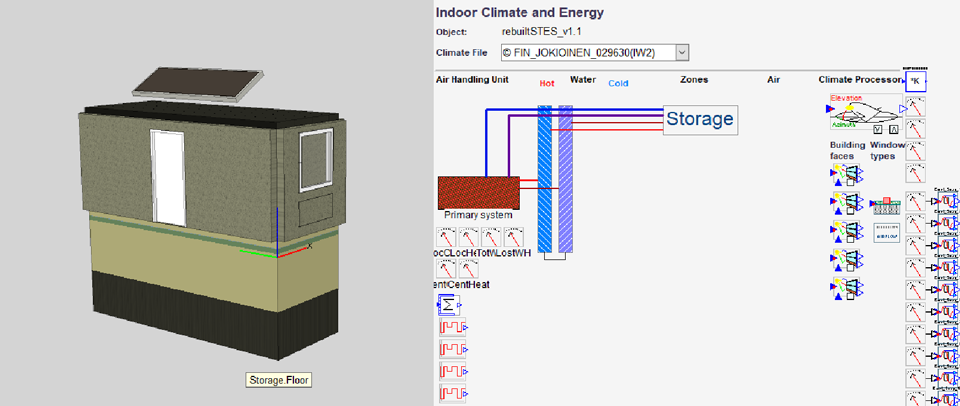
In conclusion, BPS not only completes but also strengthens the cohesion of the building life cycle and integrated design. It is truly a potential tool for designing advanced energy systems, plus a powerful research tool for state-of-the-art solutions. In years to come, who knows how far in advancement the digital technology can help solve our problems, but for now, simulation, in general, is happening to be one of the mightiest tools in every aspect of life.
“Learning by doing, peer-to-peer teaching, and computer simulation are all part of the same equation.”
– Nicholas Negroponte (Pattison, 2008)
All photos courtesy of Sy Nguyen-Ky, using licensed Revit 2019 and IDA ICE 4.8.
Authors
Sy Nguyen-Ky is a third-year student in Construction Engineering Degree Programme at HAMK, part-time project trainee at HAMK Tech Research Unit, Energy Efficiency group. His work involves building modelling, indoor climate and energy simulation, and data monitoring for indoor environment quality. He has strong interests in sustainable built environment, indoor climate and energy efficiency of buildings.
Nhung Nguyen works as a project engineer at HAMK Tech Research Unit, Energy Efficiency group. She graduated as a Construction Engineer from HAMK. She has been trained in green building design and building performance simulation in Vietnam. She is pursuing a Master’s degree in Energy Technology at Aalto University. Her current work involves building modelling, indoor environment, and energy simulation.
References
Bellinger, G. (2004). Simulation is not the answer [Website entry at Mental Model Musings]. Retrieved September 6, 2018, from http://www.systems-thinking.org/simulation/simnotta.htm
Hensen, J. (2007). O simulaciji karakteristika zgrade u promenljivoj zivotnoj sredini [On building performance simulation in a changing environment]. Proceedings of the 38th Int Congress on Heating, Refrigeration and Air-conditioning (pp. 57-69). Belgrade: KGH.
Pattison, K. (2008). No Child Left Offline [Interview of Nicholas Negroponte]. Fast Company. Retrieved April 17, 2019, from https://www.fastcompany.com/641161/no-child-left-offline


